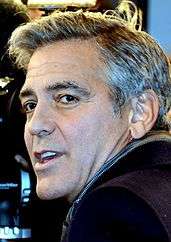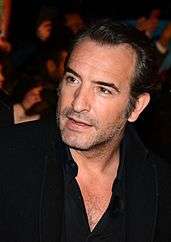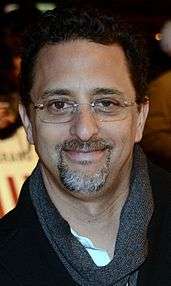The Monuments Men
| The Monuments Men | |
|---|---|
 Theatrical release poster | |
| Directed by | George Clooney |
| Produced by |
|
| Screenplay by |
|
| Based on |
The Monuments Men by Robert M. Edsel with Bret Witter |
| Starring | |
| Music by | Alexandre Desplat |
| Cinematography | Phedon Papamichael |
| Edited by | Stephen Mirrione |
Production company | |
| Distributed by |
|
Release date |
|
Running time | 118 minutes[1] |
| Country |
|
| Language | English |
| Budget | $70–91 million[2][3] |
| Box office | $155 million[2] |
The Monuments Men is a 2014 war film directed by George Clooney, and written and produced by Clooney and Grant Heslov. The film stars an ensemble cast including Clooney, Matt Damon, Bill Murray, John Goodman, Jean Dujardin, Bob Balaban, Hugh Bonneville, and Cate Blanchett.
The film is loosely based on the non-fiction book The Monuments Men: Allied Heroes, Nazi Thieves and the Greatest Treasure Hunt in History by Robert M. Edsel and Bret Witter. It follows an Allied group from the Monuments, Fine Arts, and Archives program that is given the task of finding and saving pieces of art and other culturally important items before Nazis destroy or steal them, during World War II.[4][5]
The Monuments Men was co-produced by Columbia Pictures (in association with 20th Century Fox) and Babelsberg Studio. It received mixed critical reviews and grossed $155 million worldwide against a $91 million budget.
Plot
In 1943, the Allies are making good progress driving back the Axis powers in Italy. Frank Stokes persuades President Roosevelt that victory will have little meaning if the artistic treasures of Western civilization are lost. Stokes is directed to assemble an Army unit nicknamed the "Monuments Men," comprising museum directors, curators, art historians, and an architect, to both guide Allied units and search for stolen art to return it to its rightful owners.
In July 1944, Claire Simone, a curator in occupied France, is forced to assist Nazi officer Viktor Stahl in overseeing the theft of art for either Adolf Hitler's Führermuseum or as personal property of senior commanders such as Hermann Göring. All seems lost when she discovers that Stahl is taking all of her gallery's contents to Germany as the Allies approach Paris. Simone runs to the railyard to confront him, but can only watch as he departs aboard the train carrying the cargo.
Stokes' unit finds its work frustrated by Allied officers in the field, who refuse to endanger their own troops for the sake of his mission. James Granger finds that Simone will not cooperate with those whom she suspects want to confiscate the stolen art for their own country. The unit splits up to cover more ground, with varying degrees of success. British officer Donald Jeffries sneaks into occupied Bruges at night to save Michelangelo's Madonna of Bruges, but is killed in the attempt.
Richard Campbell and Preston Savitz learn that Van Eyck's Ghent Altarpiece was removed by the priests of Ghent Cathedral for safekeeping, but their truck was stopped and the panels taken. Eventually, they find and arrest Viktor Stahl, who is hiding as a farmer, when they identify the paintings in his house as masterpieces, at least one stolen from the Rothschild Collection.
In December 1944, Walter Garfield and Jean Claude Clermont get lost in the countryside and blunder into a firefight. Clermont is mortally wounded and dies when Garfield is unable to find medical help. Meanwhile, Simone reconsiders when Granger shows her the Nero Decree, which orders the destruction of all German possessions if Hitler dies or Germany falls, and sees him return a painting looted from a Jewish family to its rightful place in their empty home. She provides a comprehensive ledger she has compiled that provides valuable information on the stolen art and the rightful owners.
Even as the team learns that the artwork is being stored in various mines and castles, it also learns that it must now compete against the Soviet Union, which is seizing artwork as war reparations. Meanwhile, Colonel Wegner is systematically destroying whole art caches. Eventually, the team has some success, as it discovers at least one mine hiding over 16,000 art pieces. In addition, the team captures the entire gold reserves of the Nazi German national treasury.
Finally, the team finds a mine in Austria that appears to have been demolished. However, they discover that the entrances were blocked by the locals to prevent the Nazis from destroying the contents. The team evacuates as much artwork as possible, including the sculpture Jeffries died trying to defend, before the Soviets arrive.
As the war comes to an end in May 1945, Stokes reports back to President Truman that the team has recovered vast quantities of artwork and various other culturally significant items. As he requests to stay in Europe to oversee further searching and restoration, Truman asks Stokes if his efforts were worth the lives of the men he lost. Stokes says they were. Truman then asks if, thirty years from then, anyone will remember that these men died for a piece of art. In the final scene, set in 1977, the elderly Stokes replies "Yeah," while he takes his grandson to see Michelangelo's Madonna.
Cast
- George Clooney as Lt. Frank Stokes, loosely based on George L. Stout
- Nick Clooney plays an aged Stokes
- Matt Damon as Lt. James Granger, loosely based on James Rorimer
- Bill Murray as Sgt. Richard Campbell, loosely based on Ralph Warner Hammett and Robert K. Posey
- John Goodman as Sgt. Walter Garfield, loosely based on Walker Hancock
- Jean Dujardin as 2nd Lt. Jean-Claude Clermont
- Bob Balaban as Pvt. Preston Savitz, loosely based on Lincoln Kirstein
- Hugh Bonneville as 2nd Lt. Donald Jeffries, loosely based on Ronald E. Balfour
- Cate Blanchett as Claire Simone, loosely based on Rose Valland
- Serge Hazanavicius as René Armand, loosely based on Jacques Jaujard
- Sam Hazeldine as Colonel Langton
- Dimitri Leonidas as Pvt. Sam Epstein, loosely based on Harry L. Ettlinger
- Grant Heslov as the Army Field Surgeon
- Miles Jupp as Major Fielding
- Justus von Dohnányi as Viktor Stahl, loosely based on Franz von Wolff-Metternich.
- Zahari Baharov as Commander Elya
Production
The Monuments Men is an American-German co-production of Columbia Pictures (in association with 20th Century Fox) and Studio Babelsberg.[6] The film was funded by the German Federal Film Fund (DFFF) with €8.5 million,[7] Mitteldeutsche Medienförderung, Medienboard Berlin-Brandenburg as well as Medien- und Filmgesellschaft Baden-Württemberg.[8][9] Casting was held in February 2013 for thousands of extras for the military scenes.[10][11]
Principal photography began in early March 2013, at the Babelsberg Studios in Potsdam, Germany, in the Berlin-Brandenburg region, and the Harz. The mines around Bad Grund, particularly the Wiemannsbucht and the Grube Hilfe Gottes, were used in the filming of outdoor scenes. Other outdoor locations were the towns of Lautenthal, Clausthal-Zellerfeld, Goslar, Halberstadt, Merseburg, and Osterwieck. Some of the scenes, including flights and American war base footage, were filmed at Imperial War Museum Duxford, Cambridgeshire, UK.[12][13] A farm in Ashford in Kent was also used.[14] Filming was scheduled to last until the end of June 2013, wrapping up in Rye, East Sussex.[15]
Release




The film was originally set to be released on December 18, 2013,[16] and a trailer was released on August 8, 2013.[17] However, on October 22, 2013, the film was pushed back to February 2014, because issues balancing humor with the serious nature of the subject matter caused post-production to take longer than expected.[18][19][20]
The film was screened on February 7, 2014 at the 64th Berlin International Film Festival.[21][22] It was also screened at UNESCO, on 27 March 2014, on the occasion of the panel discussion "Modern Day Monuments Men and Women" on the preservation of heritage in times of conflict and the fight against the illicit trafficking of cultural property.[23]
Reception
Monuments Men received mixed reviews from film critics.[24][25] On review aggregator Rotten Tomatoes, the film has a 30% approval rating, based on 240 reviews, with an average score of 5.2/10. The website's critical consensus reads, "Its intentions are noble and its cast is impressive, but neither can compensate for The Monuments Men's stiffly nostalgic tone and curiously slack narrative."[26] At Metacritic, another review aggregator, the film has a weighted average score of 52 out of 100, based on 43 critics, indicating "mixed or average reviews".[24]
Peter Travers in Rolling Stone Magazine gave it 3 out of 4 stars, noting that while some of the dialogue and emotions seemed inauthentic, the physical production and cinematography were "exquisite," with shooting done on locations in Germany and England.[27] In comparing the film with contemporary ones, he considered it a "proudly untrendy, uncynical movie," where the story involved people seeking something more valuable than money. He added, "Clooney [as director] feels there's much to be learned from these unsung art warriors...The Monuments Men is a movie about aspiration, about culture at risk, about things worth fighting for. I'd call that timely and well worth a salute."[27] He also wrote that "...[e]scapism junkies may feel betrayed", because "...Clooney has crafted a movie about aspiration, about culture at risk, about things worth fighting for"; overall, he gave it a 3/4.[28]
Richard Roeper from the Chicago Sun-Times called the film an "...engaging, shamelessly corny and entertaining World War II adventure inspired by true events"; he gave it a 3/4.[28] Film critic Richard Corliss from TIME Magazine stated that "...[r]ather than juicing each element to blockbuster volume, Clooney has delivered it in the tone of a memorial lecture, warm and ambling, given by one of the distinguished academics he put in his movie."[28]
Historian Alex von Tunzelmann, writing for The Guardian, noted several historical faults and said of the plot, "If you're getting the sense that the film is episodic and poorly structured, unfortunately you'd be right", and "There are far too many characters, so the screenplay splits them up into little groups and sends them off on various errands. Some of these are more exciting than others – but they do not add up to a satisfying plot. A TV series might have been a better vehicle for the "monuments men" stories than a feature film... The story is fascinating, but this film's good intentions are hampered by its lack of pace, direction, tone and properly fleshed-out characters."[29]
Historical accuracy
The film is based on real events, but the names of all characters were changed, and a number of further adjustments were made to the historical facts in the interests of drama.[30] Clooney is quoted as saying, "80 percent of the story is still completely true and accurate, and almost all of the scenes happened".[31]
The accounts of some events have, however, been altered to serve the film's dramatic portrayal of the retrieval of these treasures. The art at the Altaussee, Austria salt mine was saved due to the influence of Ernst Kaltenbrunner. Kaltenbrunner defied the Führer's orders to carry out the 'Nero Decree' and destroy the pieces to avoid their falling into the hands of his enemies, according to numerous real-life accounts, including an interview with Ernst Kaltenbrunner's nephew Michl Kaltenbrunner.[32]
A 1945 British Special Operations Executive misson, codenamed Bonzos and led by Albrecht Gaiswinkler, was responsible for saving the looted art stored in Austrian salt mines. Albrecht Gaiswinkler was parachuted back into the Aussee area with three colleagues: Valentin Tarra, Johann Moser, and Hans Renner. The Germans had pillaged a huge number of European art treasures during the Nazi period, and stored many of them in the Altaussee salt mine near Gaiswinkler's home town of Bad Aussee. After being dropped into the local area, Gaiswinkler raised a force of around 300 men, armed them with captured German weapons, and spent the last weeks and months of the war harassing local German forces. When the Americans arrived, his information helped them capture several eminent Nazis. He and his colleagues had captured the salt mine, prevented the destruction of the artworks held there, and were able to hand over "a number of Nazi treasure hoards, including the Mona Lisa and the Austrian Imperial Crown Jewels". Other artworks rescued included Van Eyck's Ghent Altarpiece.[33][34][35][36][37][38]
Nigel Pollard of Swansea University awarded the film only two stars out of five for historical accuracy.[39] Pollard wrote, "There’s a kernel of history there, but The Monuments Men plays fast and loose with it in ways that are probably necessary to make the story work as a film, but the viewer ends up with a fairly confused notion of what the organisation Monuments, Fine Arts, and Archives program (MFAA) was, and what it achieved. The real organisation was never a big one (a few dozen officers at most), but the film reduces it to just seven men to personalise the hunt for the looted art: five Americans, one British officer, the first to be killed off (Hugh Bonneville) and a Free French officer, marginalising the British role in the establishment of the organisation. This is presented as set up at Clooney's [Stokes'] initiative after the bombing of Monte Cassino (so, after February 1944). In fact, its origins actually went back to British efforts in Libya in 1942, and it already existed (albeit with teething troubles) when the Allies invaded Sicily in July 1943."
See also
- Rescuing Da Vinci (2006 book)
- The Rape of Europa (1994 book and 2006 documentary film)
- The Train (1964 film)
- The Hessen Affair (2009 film)
References
- ↑ "THE MONUMENTS MEN".
- 1 2 The Monuments Men at Box Office Mojo Retrieved March 26, 2014
- ↑ FilmL.A. (May 2015). "2014 Feature Film Study" (PDF). FilmL.A. Feature Film Study. Retrieved March 28, 2018.
- ↑ "George Clooney Sets Daniel Craig, Bill Murray, Cate Blanchett, Jean Dujardin For WWII Drama 'The Monuments Men'". Deadline. Retrieved November 18, 2012.
- ↑ "Directors' Page". Monuments Men Foundation for the Preservation of Art. Retrieved March 5, 2013.
- ↑ "THE MONUMENTS MEN, Directed by and Starring George Clooney, Begins Production in Germany" (Press release). Studio Babelsberg. 6 March 2013. Retrieved 28 February 2014.
- ↑ "Produktionsspiegel 2014" (PDF) (in German). Deutscher Filmförderfonds. January 6, 2014. p. 32. Archived from the original (PDF) on March 21, 2014. Retrieved March 20, 2014.
- ↑ "Rekordwert für den Deutschen Filmförderfonds". Bundesregierung - Federal Republic of Germany. 24 January 2014. Retrieved 14 February 2014.
- ↑ "George Clooney zurück in Berlin: Studio Babelsberg Koproduktion Monuments Men – Ungewöhnliche Helden hat Premiere auf der Berlinale" (Press release). Studio Babelsberg. 8 November 2013. Retrieved 28 February 2014.
- ↑ "Komparsen für Clooney-Film in Babelsberg gesucht". Berlin.de, Official Berlin press release (in German). Retrieved January 25, 2013.
- ↑ "Tausende Berliner Männer als Komparsen für die Dreharbeiten des historischen Kinofilmes THE MONUMENTS MEN" (in German). Babelsberg Studios press release. 26 January 2013. Retrieved 8 September 2013. – Appears to be accessible only if the browser's language is German.
- ↑ "IN PICTURES: Hollywood stars come to Cambridge as George Clooney films Monuments Men with Matt Damon and John Goodman". Archived from the original on October 29, 2013. Retrieved May 30, 2013.
- ↑ "George Clooney and Matt Damon try out Cambridge gym". BBC News. June 4, 2013. Retrieved June 5, 2013.
- ↑ Kent Film Office. "Kent Film Office The Monuments Men Article".
- ↑ Chitwood, Adam (March 5, 2013). "Production Begins on George Clooney's THE MONUMENTS MEN Starring Matt Damon, Cate Blanchett, and Bill Murray". Collider.com. Retrieved March 5, 2013.
- ↑ Han, Angie (December 7, 2012). "Release Dates: George Clooney's 'Monuments Men' Slotted for December 2013, Terence Malick's 'To the Wonder' Announces April Release". /Film. Retrieved March 5, 2013.
- ↑ Tapley, Kristopher (August 8, 2012). "'Monuments Men' trailer finds George Clooney and Matt Damon on the hunt for stolen art". HitFix. Retrieved August 8, 2013.
- ↑ Dockterman, Eliana (2013-10-22). "George Clooney's Monuments Men Pushed to 2014 | TIME.com". Entertainment.time.com. Retrieved 2013-11-15.
- ↑ "George Clooney Struggles With Tone of 'Monuments Men': 'It's Been a Bit of a Dance' (Exclusive)". The Wrap. 2013-10-23. Retrieved 2014-01-30.
- ↑ "The Monuments Men Moves to 2014". ComingSoon.net. Retrieved 2013-10-23.
- ↑ Fleming, Mike. "'Monuments Men' Release Date - Set For February 7, 2014". Deadline.com. Retrieved 2013-11-15.
- ↑ "The Monuments Men in the Official Programme of the 64th Berlinale". berlinale.de. Archived from the original on December 15, 2013. Retrieved November 17, 2013.
- ↑ "UNESCO Illicit Trafficking of Cultural Property". Retrieved 2014-03-27.
- 1 2 "The Monuments Men Reviews". Metacritic. CBS Interactive. Retrieved February 9, 2014.
- ↑ "George Clooney, Matt Damon Attend White House Screening Of 'The Monuments Men'". International Business Times. February 19, 2004. Retrieved October 17, 2015.
- ↑ "The Monuments Men (2013)". Rotten Tomatoes. Fandango Media. Retrieved April 10, 2018.
- 1 2 Travers, Peter (January 31, 2014). "The Monuments Men". Rolling Stone. Retrieved October 17, 2015.
- 1 2 3 "The Monuments Men - Movie Reviews". Rotten Tomatoes.
- ↑ von Tunzelmann, Alex (February 20, 2014). "The Monuments Men: a rickety plot ruins this relic hunt". The Guardian. Retrieved October 17, 2015.
- ↑ "The Monuments Men (2014)". History vs Hollywood. 2014. Retrieved 2 March 2014.
- ↑ Markovitz, Adam (Aug 12, 2013). "George Clooney talks 'The Monuments Men'". Entertainment Weekly. Retrieved 2 March 2014.
- ↑ "Has Hollywood rewritten history again? Writer claims Austrian salt miners - NOT George Clooney's 'Monuments Men' - saved priceless works of art from Nazis". Mail Online. December 23, 2013.
- ↑ Harclerode, Peter & Pittaway, Brendan (2000). The Lost Masters: Looting of Europe's Treasurehouses. London: Orion. ISBN 0-7528-3440-1.
- ↑ Mackenzie, William (2000). The Secret History of S.O.E.: Special Operations Executive 1940-1945. London: St Ermin's Press. ISBN 1-903608-11-2.
- ↑ "Albrecht Gaiswinkler, Biografie". parlament.gv.at (in German). 2013. Retrieved 17 May 2013.
- ↑ "The Last Days of Ernst Kaltenbrunner". Central Intelligence Agency. 2012. Retrieved 17 May 2013.
- ↑ Evans, Michael (2001). "Mona Lisa 'was saved from Nazis by British agent'". museum-security.org. Retrieved 17 May 2013.
- ↑ Reder, Christian (2006). "Im Salzbergwerk". christianreder.net (in German). Retrieved 17 May 2013.
- ↑ "Historian at the Movies: The Monuments Men reviewed". History Extra. Retrieved 24 February 2014.
External links
| Wikimedia Commons has media related to The Monuments Men. |